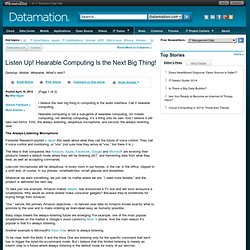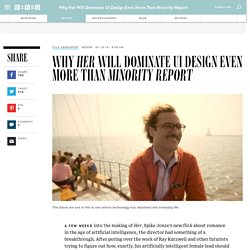

Koreshoff. I had the privilege to have a great conversation with Alexandra Deschamps-Sonsino last week, who was in town speaking at WebDirections South.

I asked her about what she thought was ‘holding up’ the IoT, and she had a great answer that really left people satisfied: People need to be patient, it took the microwave about 50 years to become popular, and now look at it, almost every household has one. While I think this sums things up nicely, there are a few underlying themes at work here that are worth exploring: A few of the things holding up the IoT: 1) Individual products don’t always make awesome networks. 2) There’s no critical mass 3) People are building ecosystems to make it feel like a critical mass (potentially good, potentially disastrous). 4) Make things that couldn’t be made before, not just quicker and faster things. 1) Individual products don’t always make awesome networks. That is to say that devices are often built with one particular function in mind. Implications for design:
Listen Up! Hearable Computing Is the Next Big Thing! I believe the next big thing in computing is the audio interface.

Call it hearable computing. Hearable computing is not a sub-genre of wearable computing, nor mobile computing, nor desktop computing. It’s a thing unto its own. And I believe it will take two forms: First, the always listening, ubiquitous microphone; and second, the always listening user. The Always-Listening Microphone Forrester Research posted a report this week about what they call the future of voice control. The idea is that companies like Amazon, Apple, Facebook, Google and Microsoft are evolving their products toward a default mode where they will be listening 24/7, and harvesting data from what they hear, as well as accepting commands.
Designing for Love in the Age of Spike Jonze's Her. We pay close attention to movies that have something important to say about love: What it is and what it’s not, how we find love (and avoid losing it) or why we need it in our lives … Her, a Spike Jonze film, is about a man in a near-future time who falls for an artificially-intelligent operating system.

The central characters may be this man and his OS, but the movie asks necessary questions about the complexity of human relationships. It’s a love story (or two) — but it’s also science fiction, delivering a clear point-of-view regarding how we’ll interact with technology in the generations to come. As we imagine what’s next, the challenge for designers and computer scientists is not how to make devices more human or more lovable. The question we should chase is: How do we avoid killing love as we increasingly rely on helpful things like technology? Spike Jonze’s Her: On Love + Technology Warner Bros. Virtual Companions and Relationship Risks Only the Lonely The Future of Love + Devices. Siri co-creator: 'don't hold your breath' for the AI in 'Her' Only a few people are truly qualified to evaluate the technological merits of Samantha, Joaquin Phoenix's A.I. co-star in Spike Jonze's film Her.

One of these people is most certainly Dag Kittlaus, co-creator of Siri. In an op-ed for Variety, he asks "Can Siri catch up? " "Maybe," he says, "but don't hold your breath. " "Samantha never made a mistake. " Kittlaus was as amused by Scarlett Johansson's Samantha as the rest of us, but questions how possible building such a computer would be. Setting aside background noise, what about the scene where Phoenix takes Samantha on a date at a carnival (in his shirt pocket) and she proceeds to make detailed observations about his surroundings?
"I don't even need to mention the complexities of building a program that's adept at verbal phone sex," he adds. Why Her Will Dominate UI Design Even More Than Minority Report. A few weeks into the making of Her, Spike Jonze’s new flick about romance in the age of artificial intelligence, the director had something of a breakthrough.

After poring over the work of Ray Kurzweil and other futurists trying to figure out how, exactly, his artificially intelligent female lead should operate, Jonze arrived at a critical insight: Her, he realized, isn’t a movie about technology. It’s a movie about people. With that, the film took shape. Sure, it takes place in the future, but what it’s really concerned with are human relationships, as fragile and complicated as they’ve been from the start. Of course on another level Her is very much a movie about technology.
When AI is cheap, what does all the other technology look like? For production designer KK Barrett, the man responsible for styling the world in which the story takes place, Her represented another sort of design challenge. Click to Open Overlay Gallery Technology Shouldn’t Feel Like Technology Go Back to Top. Joaquin Phoenix on heartbreak, rejuvenation and talking to Siri.